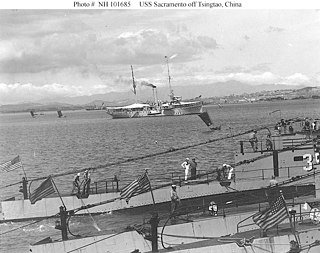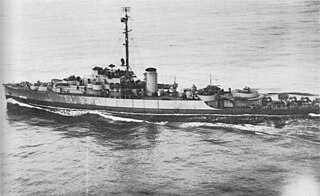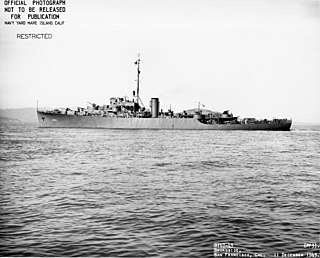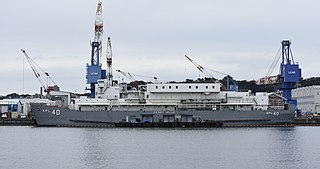
USS Frank E. Evans (DD-754), was an Allen M. Sumner-class destroyer in service with the United States Navy. She was named in honor of United States Marine Corps Brigadier General Frank Evans, a leader of the American Expeditionary Force in France during World War I. She served late in World War II and during the Korean War and Vietnam War before she was cut in half in a collision with the Royal Australian Navy aircraft carrier HMAS Melbourne in 1969.

USS Bogue (AVG/ACV/CVE/CVHE-9) was the lead ship in the Bogue class of escort carriers in the United States Navy during World War II. The ship was named for Bogue Sound in North Carolina.

USS Robison (DDG-12), named for Rear Admiral Samuel Shelburne Robison, was a Charles F. Adams-class guided missile armed destroyer in the service of the United States Navy.
The Combat Action Ribbon, is a high precedence United States Navy, United States Coast Guard, and United States Marine Corps military decoration awarded to United States sea service members "who have actively participated in ground or surface combat."

USS Bainbridge (DLGN-25/CGN-25) was a nuclear-powered guided missile cruiser in the United States Navy, the only ship of her class. Named in honor of Commodore William Bainbridge, she was the fourth US Navy ship to bear the name. With her original hull classification symbol of DLGN, she was the first nuclear-powered destroyer-type ship in the US Navy, and shared her name with the lead ship of the first US Navy destroyer class, the Bainbridge-class destroyers.

USS Leftwich (DD-984) was a Spruance-class destroyer built by the Ingalls Shipbuilding Division of Litton Industries at Pascagoula, Mississippi. She was named for Lieutenant Colonel William G. Leftwich, Jr., USMC (1931–1970), commander of the 1st Reconnaissance Battalion who was killed in action during Operation Imperial Lake in Quảng Nam Province South Vietnam on 18 November 1970 in a helicopter crash during the extraction of one of his reconnaissance teams. For this action, Lieutenant Colonel Leftwich received the Silver Star. Lieutenant Colonel Leftwich's medals and awards include: the Navy Cross, the Silver Star (posthumous), the Legion of Merit with Combat "V" and two gold stars, the Meritorious Service Medal, the Air Medal with one gold star, the Purple Heart with two gold stars, and various personal awards from the Republic of Vietnam.

The second USS Sacramento (PG-19) was a gunboat in the United States Navy.

The Tacoma class of patrol frigates served in the United States Navy during World War II and the Korean War. Originally classified as gunboats (PG), they were reclassified as patrol frigates (PF) on 15 April 1943. The class is named for its lead ship, Tacoma, a Maritime Commission (MARCOM) S2-S2-AQ1 design, which in turn was named for the city of Tacoma, Washington. Twenty-one ships were transferred to the British Royal Navy, in which they were known as Colony-class frigates, and twenty-eight ships were transferred under Lend-Lease to the Soviet Navy, where they were designated as storozhevoi korabl, during World War II. All Tacoma-class ships in US service during World War II were manned by United States Coast Guard crews. Tacoma-class ships were transferred to the United States Coast Guard and various navies post-World War II.

USS Gloucester (PF-22), a Tacoma-class frigate in commission from 1943 to 1945, was the second ship of the United States Navy to be named for Gloucester, Massachusetts. She later served in the Soviet Navy as EK-26 and in the Japan Maritime Self-Defense Force as JDS Tsuge (PF-12) and JDS Tsuge (PF-292).

USS Tacoma (PG-111/PF-3), the lead ship of the Tacoma-class patrol frigates. The third ship of the United States Navy to be named for Tacoma, Washington, she was in commission from 1943 to 1945, and from 1949 to 1951. She also served in the Soviet Navy as EK-11 and in the Republic of Korea Navy as ROKS Taedong (PF-63).

USS Sausalito (PF-4), was a Tacoma-class patrol frigate in commission from 1944 to 1945 and from 1950 to 1952, was the only ship of the United States Navy to be named for Sausalito, California. She also served in the Soviet Navy as EK-16 and in the Republic of Korea Navy as ROKS Imchin (PF-66).

The USS Tucumcari (PGH-2) was a Boeing-built hydrofoil. Named after Tucumcari, New Mexico, it was the basis for the technology used in the subsequent Pegasus-class patrol boats and the Jetfoil ferries. Its unique feature was a waterjet propulsion and a computer-controlled fully submerged foil configuration of one foil at the bow and foils on the port and starboard sides. The Tucumcari was one of two prototype boats contracted by the Navy under project SCB 252 for the purpose of evaluating the latest hydrofoil technology. The second boat was the rival Grumman-built USS Flagstaff (PGH-1).

The Asheville-class gunboats were a class of small warships built for the United States Navy in response to the Cuban Missile Crisis. The class is named for a city in western North Carolina and the seat of Buncombe County. All Asheville-class gunboats have since been donated to museums, scheduled for scrapping, or transferred to the Greek, Turkish, Colombian and South Korean Navies. The last two Asheville-class gunboats in US service were USS Chehalis and USS Grand Rapids, which were operated by the Naval Surface Warfare Center until they were stricken in 2016.

USS Tacoma (PG-92) was an Asheville-class gunboat of the U.S. Navy and the fourth ship to be named after the city of Tacoma, Washington. Tacoma was the first in a series of revised Asheville-class gunboats. Some sources call these revised boats Tacoma- or PG-92-class, but the U.S. Navy officially designates them as Asheville-class. The keel of Tacoma was laid 24 July 1967 at the Tacoma Boatbuilding Company, in her namesake city. She was launched on 13 April 1968, sponsored by Mrs. Arne K. Strom, and was commissioned on 14 July 1969.

USS Firm (AM-444/MSO-444) was an Aggressive-class minesweeper in the United States Navy.

USS Marathon (PGM-89/PG-89) was an Asheville-class gunboat acquired by the U.S. Navy for the task of high speed patrolling in shallow waterways.

USS General W. H. Gordon (AP-117) was a troop transport that served with the United States Navy in World War II. After the war, she was transferred to the US Army and served as USAT General W. H. Gordon. In the mid to late 1940s she sailed in trans-Pacific American President Lines passenger service with sister ship SS General Meigs. With the outbreak of the Korean War, she was reacquired by the Navy as a civilian-crewed Military Sea Transportation Service (MSTS) vessel, and redesignated USNS General W. H. Gordon (T-AP-117). She served again under the same designation in the Vietnam War.

The second USS Welch (PGM-93/PG-93) was a Asheville-class gunboat in the United States Navy during the Vietnam War.

The SS Minot Victory was a Victory ship built during World War II under the Emergency Shipbuilding program. She was laid down and launched by the Oregon Shipbuilding Corporation, and completed on February 1, 1945. The ship's United States Maritime Commission designation was VC2-S-AP3 and hull number 149 (1203). The Maritime Commission turned it over for merchant navy operation to a civilian contractor, the Isthmian Steamship Company under the United States Merchant Marine act for the War Shipping Administration. She was named after Minot, Maine and Minot, North Dakota.

USS Nueces (APB-40) is a Benewah-class barracks ship of the United States Navy. She was notable for her service in the Vietnam War.



















